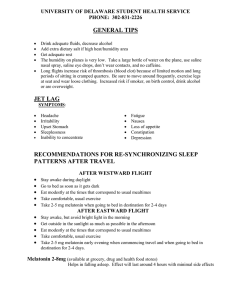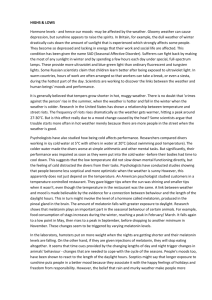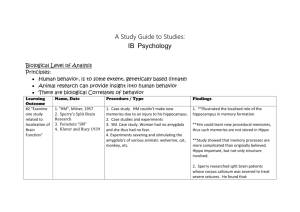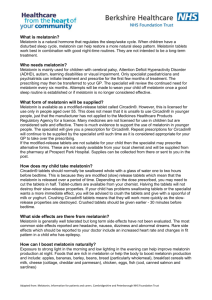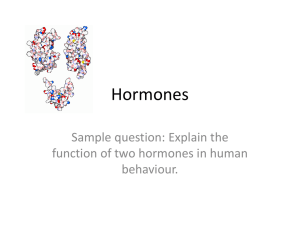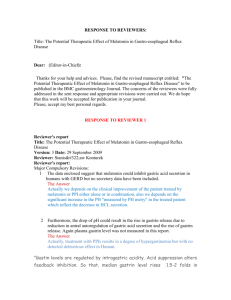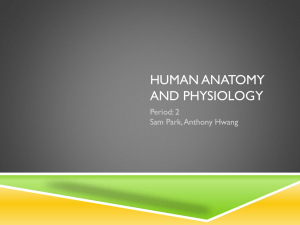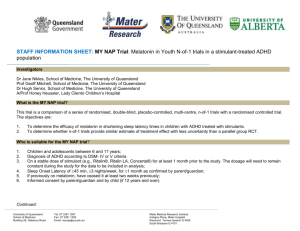International Journal of Animal and Veterinary Advances 4(3): 170-172, 2012
advertisement
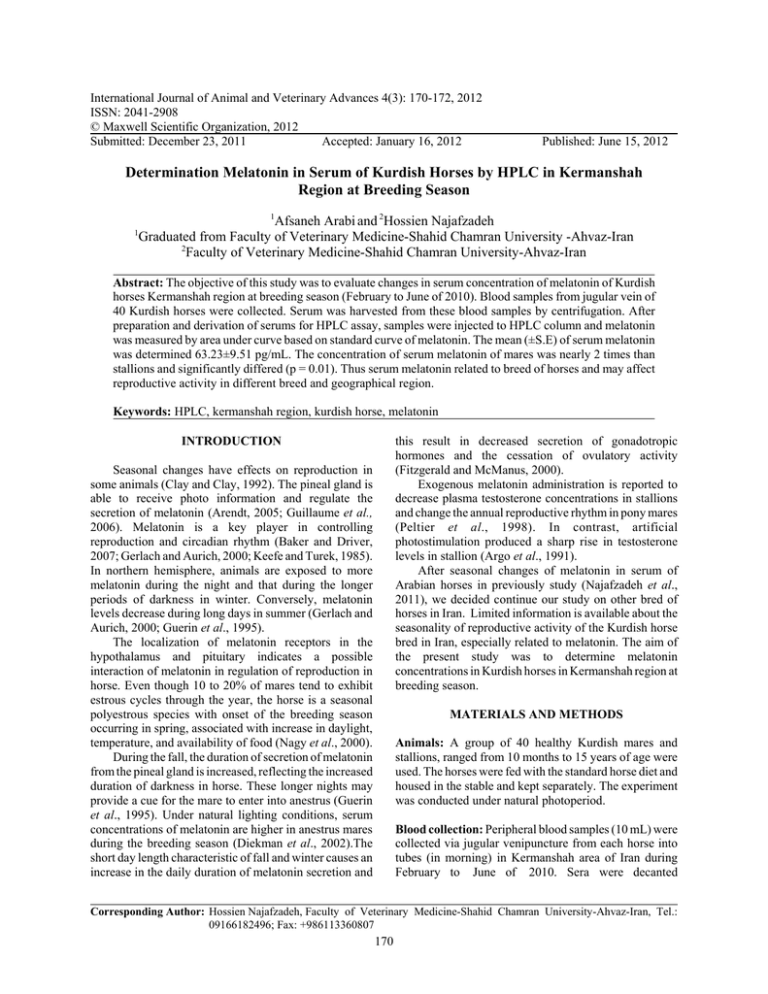
International Journal of Animal and Veterinary Advances 4(3): 170-172, 2012 ISSN: 2041-2908 © Maxwell Scientific Organization, 2012 Submitted: December 23, 2011 Accepted: January 16, 2012 Published: June 15, 2012 Determination Melatonin in Serum of Kurdish Horses by HPLC in Kermanshah Region at Breeding Season 1 1 Afsaneh Arabi and 2Hossien Najafzadeh Graduated from Faculty of Veterinary Medicine-Shahid Chamran University -Ahvaz-Iran 2 Faculty of Veterinary Medicine-Shahid Chamran University-Ahvaz-Iran Abstract: The objective of this study was to evaluate changes in serum concentration of melatonin of Kurdish horses Kermanshah region at breeding season (February to June of 2010). Blood samples from jugular vein of 40 Kurdish horses were collected. Serum was harvested from these blood samples by centrifugation. After preparation and derivation of serums for HPLC assay, samples were injected to HPLC column and melatonin was measured by area under curve based on standard curve of melatonin. The mean (±S.E) of serum melatonin was determined 63.23±9.51 pg/mL. The concentration of serum melatonin of mares was nearly 2 times than stallions and significantly differed (p = 0.01). Thus serum melatonin related to breed of horses and may affect reproductive activity in different breed and geographical region. Keywords: HPLC, kermanshah region, kurdish horse, melatonin this result in decreased secretion of gonadotropic hormones and the cessation of ovulatory activity (Fitzgerald and McManus, 2000). Exogenous melatonin administration is reported to decrease plasma testosterone concentrations in stallions and change the annual reproductive rhythm in pony mares (Peltier et al., 1998). In contrast, artificial photostimulation produced a sharp rise in testosterone levels in stallion (Argo et al., 1991). After seasonal changes of melatonin in serum of Arabian horses in previously study (Najafzadeh et al., 2011), we decided continue our study on other bred of horses in Iran. Limited information is available about the seasonality of reproductive activity of the Kurdish horse bred in Iran, especially related to melatonin. The aim of the present study was to determine melatonin concentrations in Kurdish horses in Kermanshah region at breeding season. INTRODUCTION Seasonal changes have effects on reproduction in some animals (Clay and Clay, 1992). The pineal gland is able to receive photo information and regulate the secretion of melatonin (Arendt, 2005; Guillaume et al., 2006). Melatonin is a key player in controlling reproduction and circadian rhythm (Baker and Driver, 2007; Gerlach and Aurich, 2000; Keefe and Turek, 1985). In northern hemisphere, animals are exposed to more melatonin during the night and that during the longer periods of darkness in winter. Conversely, melatonin levels decrease during long days in summer (Gerlach and Aurich, 2000; Guerin et al., 1995). The localization of melatonin receptors in the hypothalamus and pituitary indicates a possible interaction of melatonin in regulation of reproduction in horse. Even though 10 to 20% of mares tend to exhibit estrous cycles through the year, the horse is a seasonal polyestrous species with onset of the breeding season occurring in spring, associated with increase in daylight, temperature, and availability of food (Nagy et al., 2000). During the fall, the duration of secretion of melatonin from the pineal gland is increased, reflecting the increased duration of darkness in horse. These longer nights may provide a cue for the mare to enter into anestrus (Guerin et al., 1995). Under natural lighting conditions, serum concentrations of melatonin are higher in anestrus mares during the breeding season (Diekman et al., 2002).The short day length characteristic of fall and winter causes an increase in the daily duration of melatonin secretion and MATERIALS AND METHODS Animals: A group of 40 healthy Kurdish mares and stallions, ranged from 10 months to 15 years of age were used. The horses were fed with the standard horse diet and housed in the stable and kept separately. The experiment was conducted under natural photoperiod. Blood collection: Peripheral blood samples (10 mL) were collected via jugular venipuncture from each horse into tubes (in morning) in Kermanshah area of Iran during February to June of 2010. Sera were decanted Corresponding Author: Hossien Najafzadeh, Faculty of Veterinary Medicine-Shahid Chamran University-Ahvaz-Iran, Tel.: 09166182496; Fax: +986113360807 170 Int. J. Anim. Veter. Adv., 4(3): 170-172, 2012 Table 1: Statistical parameters of serum melatonin of Kurdish horses Mean SE Group (pg/mL) of mean Median Minimum Maximum Mare 84.84 11.02 89.47 5.13 114 Stallion 38.91 11.13 32.96 1.92 100.55 Total 63.23 9.51 71.41 1.92 114 reproductive activity via photoperiodic cues mediated by the secretion of melatonin from the pineal gland is reported in ewes (Bittman et al., 1983; Matthews et al., 1993), but the relationship is less clear in mares (Diekman et al., 2002; Kilmer et al., 1982). Under natural photoperiodic conditions, serum concentrations of melatonin are higher in anestrus mares (Diekman et al., 2002; Sharp et al., 1980). In response to artificial photoperiod, alterations in ovulatory season also exhibit in mares (Freedman et al., 1979; Kooistra and Ginther, 1975). In contrast to the human, the horse appears to possess a circadian pacemaker that is more amenable to rapid adjustment to a new photoperiod, suggesting in turn that their performance capacity at a new destination might be less compromised than in human athletes (Murphy et al., 2007). The annual change in photoperiod is considered the primary environmental factor that synchronizes seasonal reproductive activity in mares (Fitzgerald and McManus, 2000). The onset of anestrus, body condition or fatness, and a hormonal product of fat cells, leptin, may play a role in modifying the response to melatonin and photoperiod in the mare. Constant administration of melatonin modified the secretion of prolactin (Fitzgerald et al., 2000); specifically, treatment suppressed the increase in prolactin during spring months. Information on photoperiod and the physiological reproductive season in Kurdish horse is very limited. Diekman et al. (2002) reported that mean melatonin levels in mares were 16 pg/mL in June and 19.5 pg/mL in December. Guillaume et al. (2006) reported that mean concentration of nocturnal melatonin were 24 pg/mL during autumn in 110 pony mares. Najafzadeh et al. (2011) reported that the season did not significantly affect serum melatonin level in Arabian horses in Ahvaz region. While, Altinsaat et al. (2009) shown the serum concentrations of melatonin were greater in the nonbreeding season than breeding season in both mares and stallions. However, Fitzgerald and Schmidt (1995) reported that there is no association between melatonin and reproductive activity in mares during the nonbreeding season. In conclusion, our observations suggested a role for melatonin in the breeding activity in the Kurdish mare. However, additional study will be required to determine melatonin and other factors such as aging, nutrition, and climate are involved in seasonal changes of in reproductive activity of Kurdish horses in Kermanshah area. immediately into eppendorfs after centrifugation at 3000 rpm for 10 min and stored at -20ºC until melatonin measurement. Melatonin measurement: Serum concentration of melatonin was measured by High-Performance Liquid Chromatography (HPLC) according to modified protocols were available for determination of melatonin in serum by HPLC (Bechgaard et al., 1998; Itoh et al., 1999; PenistonBird et al., 1993; Gupta et al., 2006). Serum was extracted with trichloroacetic acid. After centrifugation, the supernatant was evaporated, and the residue was stored at -20ºC until analysis by HPLC. The recovery of the extraction procedure was 81±5.1% (mean±SEM, n = 4). The dried residue was redissolved in 500 :L of the HPLC mobile phase consisting of 60/40 methanol/water (v/v), and then filtered through a 0.45 :m filter. The filtrate (20 :L) was applied to a chromatographic system equipped with a column (C18) and a UV detector (Shimadzu, Japan). The detector was operated at a wavelength of 254 nm. All separations were carried out isocratically at a flow rate of 0.6 mL/min using the above-mentioned HPLC mobile phase at 37ºC. The melatonin concentration of samples was calculated based on Area Under Curve (AUC) and equation of standard curve which achieved by serial dilution of melatonin (sigma, USA). The mean of serum melatonin was statistically determined using SPSS program and compared by independent t-student test. The minimum level of significance was p#0.05. RESULTS The mean (±S.E) of serum melatonin of mare was determined 84.84±11.02 pg/mL. This concentration was nearly 2 times than stallions and significantly differed (p = 0.01). Minimum concentration of melatonin of mare was measured at 5.13 pg/mL while maximum concentration was measured at 114 pg/mL. The mean (±S.E) of serum melatonin of stallion was determined 38.91±11.13 pg/mL. Minimum concentration of melatonin of stallion was measured at 1.92 pg/mL while maximum concentration was measured at 100.55 pg/mL. The total mean of melatonin was measured 63.23±9.51 pg/mL (Table 1). DISCUSSION ACKNOWLEDGMENT Photoperiodism has been known as a visual factor in regulating reproduction in seasonal breeders such as sheep, horses, hamsters, ferrets, deer, mink, skunks, voles, and wallabies (Diekman et al., 2002). Regulation of The authors wish to express their gratitude to Mr. Arabi for his helps and supports. 171 Int. J. Anim. Veter. Adv., 4(3): 170-172, 2012 Guillaume, D., L.A. Zarazaga, B. Malpaux and P. Chemineau, 2006. Variability of plasma melatonin level in pony mares (Equus caballus), comparison with the hybrid: Mules and with jennies (Equus asinus). Reprod. Nutr. Dev., 46: 633-639. Gupta, M., K. Kohli, D. Kumar and Y.K. Gupta, 2006. A reverse phase high performance liquid chromatography method for simultaneous estimation of melatonin, carbamazepine epoxide and carbamazepine simultaneously in serum. Indian J. Phys. Pharmacol., 50(4): 427-430. Itoh, M.T., B. Ishizuka, Y. Kuribayashi, A. Amemiya and Y. Sumi, 1999. Melatonin, its precursors and synthesizing enzyme activities in the human ovary. Mol. Hum. Reprod., 5(5): 402-408. Keefe, D.L. and F.W. Turek, 1985. Circadian time keeping processes in mammalian reproduction. Oxf. Rev. Reprod. Biol., 7: 346-400. Kilmer, D.M., D.C. Sharp, L.A. Bergland, W. Grubaugh, K.J. McDowell and L.S. Peck, 1982. Melatonin rhythms in pony mares and foals. J. Reprod. (Fertil) Suppl., 32: 303-307. Kooistra, L.H. and O.J. Ginther, 1975. Effect of photoperiod on reproductive activity and hair in mares. Am. J. Vet. Res., 36: 1413-1419. Matthews, C.D., M.V. Guerin and J.R. Deed, 1993. Melatonin and photoperiodic time measurement: Seasonal breeding in the sheep. J. Pineal. Res., 14: 105-116. Murphy, B.A., J.A. Elliott, D.R. Sessions, M.M. Vick, E.L. Kennedy and B.P. Fitzgerald, 2007. Rapid phase adjustment of melatonin and core body temperature rhythms following a 6-h advance of the light/dark cycle in the horse. J. Circadian Rhythm, 24;5(1): 5. Nagy, P., D. Guillaume and P. Daels, 2000. Seasonality in mares. Animal Reprod. Sci., 60-61: 245-262. Najafzadeh, H., S. Gooraninejad, A. Gadrdan, R. Fatemi and A. Raki, 2011. Determination melatonin in serum of Arabian horses by HPLC in summer and winter solstices in Ahvaz. World Appl. Sci. J., 11: 2088-2091. Peltier, M.R., G. Robinson and D.C. Sharp, 1998. Effects of melatonin implants in pony mares. 2. Long-term effects. Theriogenol, 49: 1125-1142. Peniston-Bird, J.F., W.L. Di, C.A. Street, A. Kadva, M.A. Stalteri and R.E. Silman, 1993. HPLC assay of melatonin in plasma with fluorescence detection. Clin. Chem., 39(11 Pt 1): 2242-2247. Sharp, D.C., W.R. Grubaugh, M.T. Zavy and M.W. Vernon, 1980. Seasonal variation in melatonin secretory patterns in mares. J. Anim. Sci., 51: 327. REFERENCES Altinsaat, C., A.G. Üner, N. Sulu and A. Ergun, 2009. Seasonal variations in serum concentrations of melatonin, testosterone and progester one in Arabian horse. Vet. J. Ankara Univ., 56: 19-24. Arendt, J., 2005. Melatonin: Characteristics, concerns and prospects. J. Biol. Rhythms, 20: 291-303. Argo, C.M. and J.E. Cox and J.L. Gray, 1991. Effect of oral melatonin treatment on the seasonal physiology of pony stallions. J. Rep. Fertil Suppl, 44: 115-125. Baker, F.C. and H.S. Driver, 2007. Circadian rhythms, sleep and the menstrual cycle. Sleep Med., 8: 613-622. Bechgaard, E., K. Lindhardt and L. Martinsen, 1998. High-performance liquid chromatographic analysis of melatonin in human plasma and rabbit serum with on-line column enrichment. J. Chromatogr B Bio. Sci., 712(1-2): 177-181. Bittman, E.L., R.J. Dempsey and F.J. Karsch, 1983. Pineal melatonin secretion drives the reproductive response to day length in the ewe. Endocrinol, 113: 2276-2283. Clay, C.M. and J.N. Clay, 1992. Endocrine and testicular changes associated with season, artificial photoperiod and the peri-pubertal period in stallions. Vet. Clin. North Am. Equine Pract., 8: 31-56. Diekman, M.A., W. Braun, D. Peter and D. Cook, 2002. Seasonal serum concentrations of melatonin in cycling and noncycling mares. J. Anim. Sci., 80: 2949-2952. Fitzgerald, B.P. and M.J. Schmidt, 1995. Absence of an association between melatonin and reproductive activity in mares during the nonbreeding season. Biol. Reprod. Monogram, 1: 425-434. Fitzgerald, B.P. and C.J. Mc. Manus, 2000. Photoperiodic versus metobalic signal as determents of seasonal anestrus in the mare. Bio. Reprod., 63: 335-340. Fitzgerald, B.P., L.A. Davison and C.J. McManus, 2000. Evidence for a seasonal variation in the ability of exogenous melatonin to suppress prolactin secretion in the mare. Domest. Anim. Endocrinol., 18: 395-408. Freedman, L.J., M.C. Garcia and O.J. Ginther, 1979. Influence of photoperiod and ovaries on seasonal reproductive activity in mares. Biol. Reprod., 20: 567-574. Gerlach, T. and J.E. Aurich, 2000. Regulation of seasonal reproductive activity in the stallion, ram and hamster. J. Animal Reprod. Sci., 58: 197-213. Guerin, M.V., J.R. Deed, D.J. Kennaway and C.D. Matthews, 1995. Plasma melatonin in the horse: Measurements in natural photoperiod and in acutely extended darkness throughout the year. J. Pineal Res., 19: 7-15. 172
